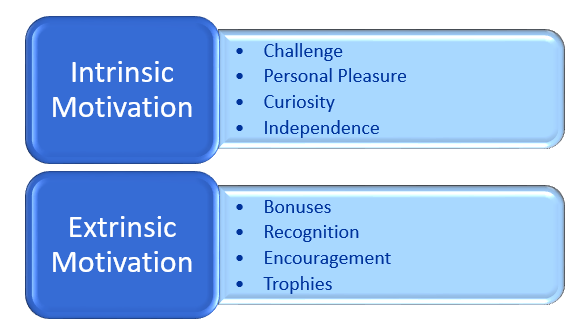Motivation is a drive or desire to behave in a certain way. While there are many different types of motivation, the broadest types are intrinsic and extrinsic motivation. These two represent all internal and external influences on motivation.
Two Types of Motivation
Extrinsic Motivation is doing an activity to gain a reward or avoid a punishment.
Intrinsic Motivation is doing an activity for personal satisfaction or enjoyment.
Difference between Intrinsic and Extrinsic Motivation
Intrinsic motivation comes from within an individual, while extrinsic motivation arises from external sources. Intrinsic motivation centers on doing an activity because it is enjoyable and personally gratifying. Conversely, extrinsic motivation involves doing something to earn a reward or avoid punishment.
When an individual is intrinsically motivated, they engage in an activity because they enjoy it and get personal satisfaction from doing it. However, when a person is extrinsically motivated, they typically do something in order to gain an external reward.
Intrinsic motivation is more sustainable than extrinsic motivation because it usually focuses on personal gratifying things a person can control. On the contrary, extrinsic motivation typically focuses on things that are given to a person by someone else and therefore is not directly within their control.
About Intrinsic Motivation
Intrinsic motivation means that the individual’s motivational stimuli is coming from within. The individual has the desire to perform a specific task because taking part in an activity brings personal joy and satisfaction. When intrinsically motivated, a person is moved to act for the fun or challenge rather than because of external pressure or reward.
People who are motivated intrinsically engage in an action or set out to achieve a goal because it is internally satisfying or rewarding. Typically, the action or achievement of the goal itself is the motivating factor rather than the reward at the end. For example, a person may be motivated to get a promotion not for the money, but for the personal challenge. Additionally, a person might be motivated to succeed because they want to positively affect the lives of the people around them.
The benefit of intrinsic motivation is that it comes from the person themselves. It focuses on personal gratifying things a person can control and is not reliant on trying to figure out what will motivate a person to perform a specific task.
Sources of Intrinsic Motivation
- Challenge
- Curiosity
- Personal ethics
- Independence
- Acceptance
- Social interactions
About Extrinsic Motivation
Extrinsic motivation means that the individual’s motivational stimuli come from sources originating outside the individual. In other words, a person’s desire to perform an activity is initiated by an external source rather than from within.
Extrinsic motivation is often positive and driven by gains for the individual such as the acquisition of rewards, money, praise, or power. However, extrinsic motivation can sometimes be negative. It can involve fear of losing something or simply avoiding something, such as negative consequences or punishments. For example, a person can be motivated to perform better at a job due to a monetary bonus or just the fear of being fired.
A problem with extrinsic motivation is that it can be prone to expectations. If a person is consistently getting a reward for performing a task, they will expect the reward every time they perform the task. If the person does not receive the reward, they often stop performing a quality task.
Another problem with extrinsic motivation is that it can lack meaning or connection with the individual’s desires. For example, an external incentive offered to the individual could be money while the individual prefers time off. The lack of connection between the reward and the individual’s desire would not motivate them to perform the task.
Sources of Extrinsic Motivation
- Money
- Award or trophy
- Benefit package
- Promotion
- Feedback
- Praise or recognition
Both Extrinsic and Intrinsic Motivation
Many times, the motivation behind the actions can be both extrinsic and intrinsic. The action may be originally initiated by an outside source such as a reward or benefit, but it can still have intrinsic stimuli which causes the individual to be further motivated. For example, a person may be offered to be paid to coach a youth league. Even though the initial stimuli are coming from outside, the result of performing the task may still be personally gratifying for the individual performing the task.


